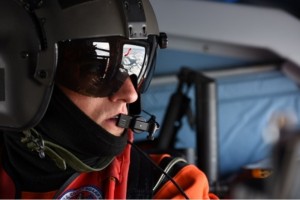
DEADHORSE, Alaska — The Coast Guard Research and Development Center held a joint exercise with civil counterparts in the Arctic Ocean near Oliktok Point Monday and Tuesday.
The exercise was the product of a cooperative research and development agreement between the RDC and ConocoPhillips Co. to assess the application of unmanned technologies and improve collaboration between civil and federal entities during response operations.
“Federal, state, municipal, and private collaboration on the North Slope, where assets and resources are scarce, is vital to response mission success,” said Rich Hansen, Arctic coordinator at the RDC.
Coast Guard assets and personnel from the RDC, Coast Guard Cutter Healy, Coast Guard 17th District, and Coast Guard Air Station Kodiak joined representatives from ConocoPhilips Co., Insitu Inc., Era Helicopters, Priority 1 Air Rescue, the Department of Energy, the National Oceanic and Atmospheric Administration, the Federal Aviation Administration and North Slope Borough for the two-day exercise. The team responded to a simulated downed aircraft just north of Oliktok Point. The Healy deployed a six-man life raft and thermal dummy in the icy waters which simulated the aircraft’s survivors for the exercise.
During the first day of the exercise, ConocoPhillips Co. provided an Insitu Inc. unmanned aircraft system launched from DOE’s Sandia National Laboratory-operated shore facility out to the Healy. Shore operators then successfully transferred control of the UAS to the Healy to execute a search pattern provided by the Coast Guard 17th District to locate the simulated aircraft survivors.
Locating the targets in the ice-covered waters proved to be a challenge, and the Healy had to vector the UAS to the SAR targets’ location. The UAS circled above the raft and thermal dummy, relaying imagery and providing situational awareness to decision makers on Healy and back on land, while an Era Helicopters crew and Coast Guard Air Station Kodiak MH-60 Jayhawk helicopter crew deployed from the Coast Guard Arctic Shield forward operating location in Deadhorse to performed rescue operations. After the rescue concluded the Healy returned control of unmanned aircraft back to operators at Oliktok Point, where it was safely landed.
On the second day the team executed the exercise again, this time launching NOAA’s UAS deployed aboard Healy to locate the simulated aircraft survivors. The team experienced similar issues locating the target and NOAA’s UAS had to be vectored in by the ship. Once the UAS was over the target, the Healy passed updated position information from the UAS to the two manned aircraft out of Deadhorse and vectored them in for recovery.

“Some UAS have the endurance to stay in the air for several hours and even up to a full day, which is beneficial when executing lengthy search patterns,” said Lt. Keely Higbie, a member of the exercise planning team from the RDC. “The use of UAS in response operations has the potential to reduce manned aircraft time on-scene and is an exceptional resource for providing situational awareness during response and recovery efforts. Additionally, launching and recovering UAS from a shore location allows for the majority of logistical support to be on land, tying up less space on our cutters and provides an eye in the sky for Coast Guard assets that are not equipped with flight decks during response operations.”
The imagery from the UAS was broadcast live through NOAA’s Arctic Environment Response Management Application and could be viewed from a link online, demonstrating the ability to provide situational awareness to Coast Guard decision makers anywhere in the country.
“The lessons learned from this exercise will help facilitate collaborative response efforts in the future as well as develop requirements, tactics, techniques, and procedures for unmanned technologies that could be leveraged for those responses in the Arctic environment,” Hansen said.
